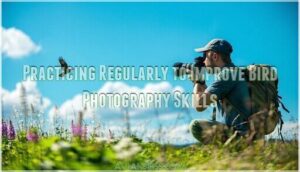This site is supported by our readers. We may earn a commission, at no cost to you, if you purchase through links.

Switch to manual mode and use spot metering to measure light directly off the bird, not the sky. This prevents your feathered subject from becoming a dark silhouette.
Shoot in RAW format so you can recover details later. Position yourself with the sun at your back when possible, or wait for softer light during golden hour.
Manual mode gives you complete control over your exposure triangle. The key is understanding that your camera wants to average everything to middle gray, but birds against bright skies need different treatment.
Table Of Contents
- Key Takeaways
- The Challenge of Photographing Birds Against a Bright Sky
- Switching to Manual Mode and Spot Metering
- Choosing The Perfect Time and Position
- Knowing The Birds’ Flight Paths
- Adjusting Camera Settings for Bird Photography
- Pre-Focusing Your Camera
- Maintaining Proper Body Posture and Stability
- Trying Bump Focus Technique
- Firing Your Shots and Keeping The Bird in Frame
- Practicing Regularly to Improve Bird Photography Skills
- Frequently Asked Questions (FAQs)
- What is the best setting for photographing birds?
- What AF mode should I use for bird photography?
- What shutter speed and ISO for birds in flight?
- How to photograph bright sky?
- What lens focal length works best for birds?
- How do weather conditions affect bird photography?
- What backup equipment should photographers carry?
- Which camera brands perform better for birds?
- How close can you get without disturbing birds?
- Conclusion
Key Takeaways
- Switch to manual mode and use spot metering on the bird itself – this prevents your camera from being fooled by the bright sky and turning your subject into a dark silhouette
- Shoot in RAW format so you’ll have maximum flexibility during post-processing to recover blown highlights from the sky and lift shadows on the bird
- Position yourself with the sun at your back when possible, or wait for golden hour lighting – this illuminates your feathered subject naturally while reducing harsh contrast
- Master your camera’s continuous autofocus mode and practice tracking birds smoothly – combine this with burst mode and proper shutter speeds above 1/500s to freeze wing movement
The Challenge of Photographing Birds Against a Bright Sky
Imagine this scenario: you’ve spotted the perfect bird soaring against a brilliant blue sky, but your camera turns it into a dark silhouette.
This classic bright sky bird photography challenge stumps many photographers, as your camera’s meter reads the blazing background and underexposes the subject.
The solution requires mastering exposure control and understanding bird behavior.
Switch to manual mode, use spot metering on the bird itself, and shoot in RAW for flexible image processing.
Monitor your histogram for balanced exposure across highlights and shadows, and proper camera settings and positioning with the sun behind you’ll transform those frustrating silhouettes into stunning bird photos against sky.
Switching to Manual Mode and Spot Metering
When your camera’s automatic exposure gets confused by bright skies, switching to manual mode puts you back in control.
You’ll combine this with spot metering techniques to nail the perfect exposure on your feathered subject every time.
Understanding Exposure Control
When bright skies fool your camera’s metering system, you’ll need to take control.
Don’t let bright skies turn your perfect bird into a dark silhouette.
Switch from auto exposure modes to manual mode for consistent results. Your camera meter reads the scene as middle gray, underexposing dark birds against brilliant skies.
Master aperture control, shutter speed, and ISO settings to override these automatic decisions. Manual exposure settings give you the power to properly expose your subject regardless of background brightness.
Understanding the exposure triangle is essential for achieving balanced and well-controlled images in various lighting conditions.
Using The Histogram for Proper Exposure
Your histogram becomes your exposure compass when photographing birds against bright skies.
This graphical display shows light distribution across your image, preventing blown highlights and crushed shadows. A balanced histogram indicates proper exposure control, while spikes on the right signal overexposure.
Monitor your camera’s live histogram while adjusting manual mode settings to maintain image balance and avoid clipped details. Understanding the photography histogram is essential for capturing well-exposed images in various lighting conditions, and a balanced histogram is key to achieving this, with proper exposure control being crucial, and using the exposure compass to guide you, while also considering well-exposed images.
Shooting in RAW Format for Editing Flexibility
When you’re out there with your camera, shooting in RAW format becomes your safety net for tricky lighting situations.
RAW format preserves every bit of image data your sensor captures, giving you incredible editing flexibility during post processing. Unlike JPEG files that compress and discard information, RAW maintains full dynamic range and color depth.
This means you can recover blown highlights from bright skies or lift shadows on underexposed birds without destroying image quality. In manual mode, RAW format lets you push exposure boundaries knowing you’ll have room to adjust later.
Your camera’s RAW files contain 12-16 bits of color information compared to JPEG’s 8 bits, providing smoother gradations and more natural color grading options. This extra data proves invaluable when balancing exposure between dark bird subjects and brilliant skies.
Understanding the benefits of RAW camera format is essential for capturing high-quality images in various lighting conditions.
Post-Processing Techniques
RAW files reveal your creative potential in postprocessing. After importing your bird shots, you’ll discover hidden details that seemed lost forever.
Start with these essential steps:
- Exposure adjustments – Pull back blown highlights and lift crushed shadows using global sliders
- Targeted corrections – Apply layer blending with masks to separately enhance sky and bird regions
- Final polish – Use sharpening tools for feather detail and noise reduction to clean high-ISO grain
Smart image editing means working the histogram like a pro. Highlight recovery saves overexposed skies while shadow boosting reveals dark bird features.
Color grading adds that professional touch, making your shots pop without looking overdone.
Choosing The Perfect Time and Position
Timing and positioning can make or break your bird-against-sky shots, turning frustrating silhouettes into stunning portraits.
You’ll want to position yourself with both the sun and wind at your back – this combo illuminates your feathered subject while encouraging birds to fly directly toward your lens, making for a great portrait.
Ideal Lighting Conditions
Timing matters more than expensive gear when shooting birds against bright skies.
Golden Hour provides the sweet spot—soft light that won’t blow out your exposure or turn your feathered subjects into silhouettes.
| Lighting Condition | Best For |
|---|---|
| Dawn Break | Sharp contrast, dramatic rim lighting |
| Golden Hour | Natural diffusion, warm tones |
| Overcast Skies | Even exposure, reduced harsh shadows |
| Bright Midday | Fast shutter speeds, challenging exposure |
Overcast conditions act like nature’s softbox, creating natural diffusion that eliminates the harsh contrast between your subject and the sky.
This makes exposure control much simpler—you won’t need those tricky compensation adjustments that bright sky photography typically demands.
Manual Mode Advantages
Breaking free from auto mode’s guesswork, manual exposure gives you complete camera control over every shot.
You’ll set ISO settings, shutter speed, and aperture priority yourself, eliminating the frustration of underexposed birds against bright skies.
This exposure control lets you nail consistent results in challenging bright sky photography conditions, making bird photography techniques more predictable than relying on spot metering alone, which is crucial for achieving predictable outcomes.
Positioning for Better Shots
Position yourself with the sun at your back to illuminate birds while minimizing harsh shadows.
Sun at your back turns bird silhouettes into perfectly lit portraits.
Study wind patterns** since birds typically fly into headwinds – positioning upwind increases your chances of capturing them approaching.
Use camera angles that place birds against clean sky backgrounds for better subject separation.
Scout flight paths during different seasons to predict ideal bird tracking positions and master background control techniques.
Knowing The Birds’ Flight Paths
Understanding bird behavior gives you a massive advantage in the field.
Research your target species online using identification guides to learn their habitat preferences, feeding schedules, and Bird Migration patterns.
During roosting seasons, you’ll find consistent Flight Patterns as birds leave their sleeping spots at dawn or return at dusk.
Species Behavior varies dramatically – raptors often circle thermals midday, while waterfowl follow predictable routes between feeding and resting areas.
Scout locations during different seasons since Habitat Research reveals how birds adapt their flight paths based on weather and food availability.
Bird Tracking becomes easier when you know their daily routines.
Position yourself along known flyways, especially near water sources where birds congregate.
Wind direction affects flight paths too – birds typically fly into headwinds, so study local weather patterns.
These bird photography tips transform random encounters into planned opportunities, making photography birds in flight against bright skies much more predictable and successful.
Adjusting Camera Settings for Bird Photography
Getting your camera settings right makes the difference between a dark silhouette and a perfectly exposed bird against that bright sky.
You’ll need to master your shutter release technique and dial in the right autofocus settings to nail those tricky shots.
Using The Shutter Release to Focus
With your camera ready, master the shutter release‘s half-press technique for bird photography against sky.
Half-press activates autofocus and locks onto your target, while full-press captures the shot.
This two-stage approach guarantees sharp focus before triggering burst shooting mode.
Proper shutter speed settings freeze wing movement, while camera stability prevents blur during the focusing process.
Selecting Autofocus and Focus Patterns
Your autofocus success depends on matching the right mode to bird behavior.
Switch to AF-C (Continuous Autofocus) for moving subjects—it’ll track birds whether they’re perched or soaring.
Here’s your tactical approach:
- Single-point focus for stationary birds perched on branches
- Zone focusing for erratic flight patterns and unpredictable movement
- Wide-area modes for fast-approaching subjects filling your frame
Configure burst shooting with back-button focus to separate focusing from shutter release, giving you precise camera tracking control for subject isolation.
Understanding autofocus camera settings is essential for capturing sharp images of birds in various environments.
Utilizing The Focus Limiter
Speed matters when birds dart across bright skies.
Enable your telephoto lens’s focus limiter to restrict autofocus range, dramatically improving tracking speed.
Set the limiter to exclude close distances – you won’t need macro focus for distant subjects anyway.
This simple autofocus tip transforms sluggish focus modes into responsive tools, giving you control over focus optimization.
Smart camera calibration beats chasing every branch and cloud.
Paying Attention to Camera Settings
Once you’ve set your focus limiter, your camera modes become your best friend.
Manual mode gives you complete exposure control when birds dart across bright skies.
Set aperture priority at f/8 for sharpness, then adjust shutter speed above 1/500s to freeze wing movement.
Your ISO settings will compensate for changing light.
Modern autofocus systems work best when you’re not fighting automatic exposure decisions that get confused by brilliant backgrounds.
Understanding the right aperture settings is essential for capturing sharp images of birds against a bright sky.
Pre-Focusing Your Camera
Three essential steps will transform your prefocus game and boost your bird photography success rate. Start by selecting a long telephoto prime lens—they’re faster and sharper than zooms.
Next, predict the bird’s flight path using your species knowledge and prefocus on that spot. Your camera focus will lock instantly when the subject appears. Enable focus limiter to prevent autofocus from hunting foreground distractions.
- Choose prime lenses over zooms for superior autofocus speed and image quality
- Study bird behavior to predict flight paths and prefocus on likely approach zones
- Enable focus limiter to restrict autofocus range and prevent background hunting
- Use bump focusing by half-pressing the shutter to wake autofocus as birds approach
- Practice focus techniques regularly—sharp flight shots require muscle memory and timing
Maintaining Proper Body Posture and Stability
The foundation of sharp bird photography lies in rock-solid camera stability and proper body positioning.
Plant your feet shoulder-width apart with knees slightly bent—think athletic stance, not rigid soldier.
This creates your base for tracking fast-moving subjects across the sky.
Your left hand becomes the lens cradle, supporting weight from underneath while your right grips the camera body.
Tuck those elbows against your ribs; they’re your natural tripod.
This hand placement distributes the camera’s weight evenly and reduces fatigue during long shooting sessions.
Keep your torso upright but relaxed.
When following a bird’s flight path, pivot from your hips and core—not just your arms.
This footing technique maintains balance while allowing smooth panning motions.
Press the viewfinder firmly against your brow for additional stability.
Breathe steadily and squeeze the shutter gently rather than jabbing it.
Even without tripod usage, proper bird photography body position transforms your entire body into a stable platform for capturing tack-sharp images against bright backgrounds.
To attract birds for better photography opportunities, consider ideal bird feeder placement strategies.
Trying Bump Focus Technique
When birds approach against bright skies, bump focus becomes your secret weapon for razor-sharp images. This technique involves intermittently pulsing your autofocus button to override tracking delays and maintain crisp focus on fast-moving subjects.
As you track the bird’s flight path, release and re-engage the shutter release button strategically. Time your bumps based on the bird’s speed—faster subjects need more frequent pulses.
Practice this rhythm while maintaining smooth camera stabilization and bird tracking. Combined with fast shutter speeds and proper autofocus modes, bump focus dramatically improves your hit rate in challenging bright sky conditions.
Mastering autofocus techniques is essential for capturing sharp images of birds in various environments.
Firing Your Shots and Keeping The Bird in Frame
Once you’ve locked onto your target, timing becomes everything in bird photography. Your bird tracking skills will determine whether you capture a sharp image or miss the shot entirely.
Keep your camera’s autofocus engaged and ready to fire multiple shots in burst mode.
Here’s how to nail the perfect capture:
- Maintain smooth camera panning to follow the bird’s flight path without jerky movements
- Fill the frame strategically by anticipating where the bird will fly next
- Lock focus early when the bird enters your viewfinder’s sweet spot
- Control shot timing by firing just before peak action moments
Your shutter speed should already be dialed in from earlier setup, but don’t forget about exposure control as lighting shifts.
The key is staying relaxed while keeping that bird in flight centered in your viewfinder. Remember, even pros miss shots – it’s all about increasing your hit rate through consistent technique and smooth follow-through.
Practicing Regularly to Improve Bird Photography Skills
Mastering bird photography against bright skies takes countless hours of dedicated Regular Practice. You can’t expect perfect shots overnight—this skill demands consistent effort and patience.
Your journey begins with structured practice sessions that build muscle memory and technical expertise:
- Study different bird behaviors to anticipate their movements and flight patterns during various seasons
- Refine your camera settings like shutter speed, aperture, and ISO for specific lighting conditions and bird actions
- Practice focusing techniques such as tracking autofocus modes and pre-focusing on anticipated flight paths
- Scout locations regularly during different times of day to understand lighting angles, backgrounds, and sighting frequency
Photo Review sessions help identify what worked and what didn’t in each shot. Analyze your images critically—check focus accuracy, exposure balance, and composition. Shooting Drills improve your reaction time when birds appear unexpectedly. Set up Editing Exercises to enhance your post-processing skills.
Understanding optimal camera settings is essential for capturing sharp images of birds in various environments.
The path to mastery requires persistence and bird photography practice importance can’t be overstated. Regular bird photography technique refinement through bird photography regular practice transforms beginners into skilled photographers.
Frequently Asked Questions (FAQs)
What is the best setting for photographing birds?
You’ll want manual mode with f/8 aperture, 1/500s shutter speed minimum, and ISO adjusted for proper exposure. Use continuous autofocus, burst mode, and shoot RAW format for best results.
What AF mode should I use for bird photography?
Looking at flying birds through your viewfinder without proper autofocus is like trying to catch lightning in a bottle with oven mitts.
Use AI Servo (Canon) or Continuous AF (Nikon) mode to track moving subjects smoothly and consistently.
What shutter speed and ISO for birds in flight?
Use 1/500s minimum shutter speed to freeze wing motion—faster speeds like 1/1000s work better for rapid fliers.
Keep ISO flexible, starting around 400-800, then adjust based on light conditions while maintaining proper bird exposure, and remember to use proper techniques for the best results.
How to photograph bright sky?
Switch to manual mode and set your exposure using the ground as reference.
Point your camera down, adjust settings until the meter reads zero, then reframe your shot.
This prevents underexposure from the bright sky fooling your camera’s meter.
What lens focal length works best for birds?
Like finding the sweet spot on a guitar, telephoto lenses between 400-600mm hit the perfect note for bird photography.
You’ll capture stunning detail without spooking your feathered subjects, giving you that frame-filling magic every birder craves.
How do weather conditions affect bird photography?
Weather dramatically impacts bird photography success.
Wind direction affects flight paths – birds typically fly into headwinds, so position yourself accordingly.
Overcast skies provide even lighting but reduce contrast.
Storms trigger migration activity, creating excellent opportunities for action shots.
What backup equipment should photographers carry?
Professional photographers face gear failure in 22% of outdoor shoots.
You’ll want extra batteries, memory cards, and lens cleaning supplies as essentials.
Pack a backup camera body if possible, plus weather protection covers and basic tools for quick fixes to prevent equipment issues.
Which camera brands perform better for birds?
Canon, Nikon, and Sony dominate bird photography with excellent autofocus systems.
Canon’s R5/R6 and Nikon’s Z9 excel at tracking fast-moving subjects.
Sony’s a7R V offers incredible resolution for detailed shots.
How close can you get without disturbing birds?
Want to capture stunning shots without spooking your subjects?
Most birds tolerate 10-30 feet before fleeing, but waterfowl and raptors need greater distance.
Start far back, use telephoto lenses, and move slowly—patience beats proximity every time.
Conclusion
Ironically, the hardest part about mastering how to photograph birds against a bright sky isn’t the technical complexity—it’s simply remembering to slow down and think before you shoot.
You’ve got the tools now: manual mode, spot metering, RAW format, and proper positioning.
The real challenge is training yourself to stop, assess the light, and make deliberate exposure decisions instead of letting your camera guess.
With consistent practice and patience, you’ll transform those frustrating silhouettes into stunning bird portraits that showcase every feather detail.

















